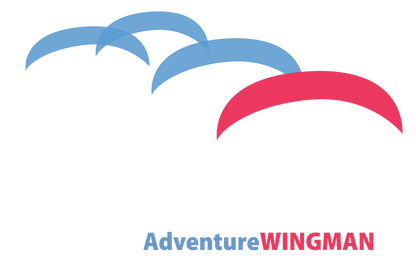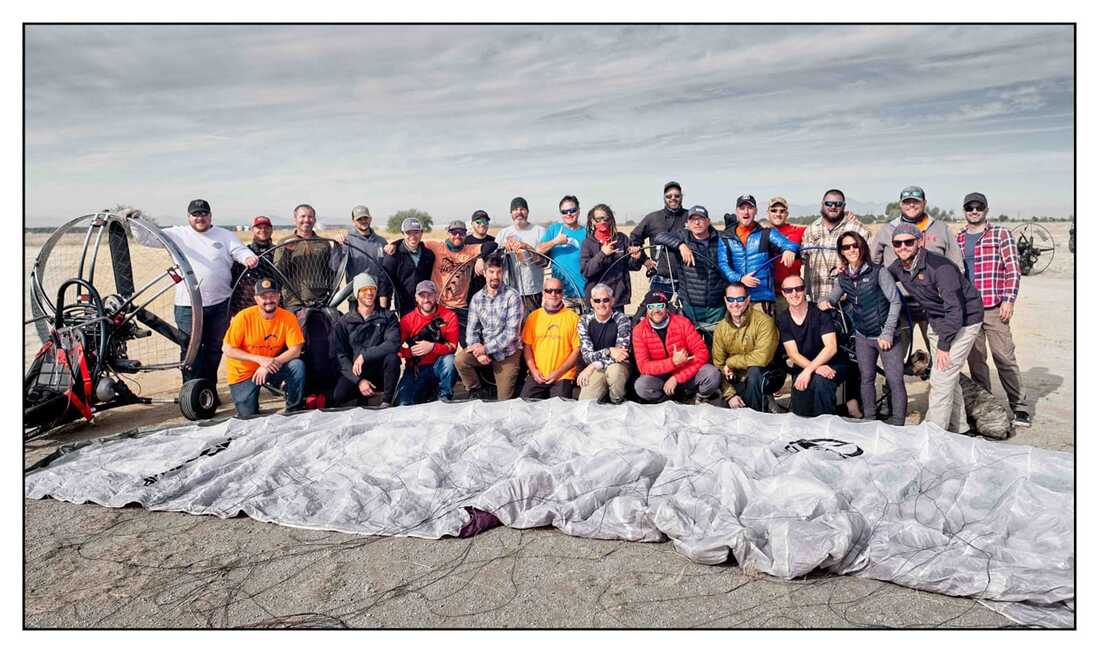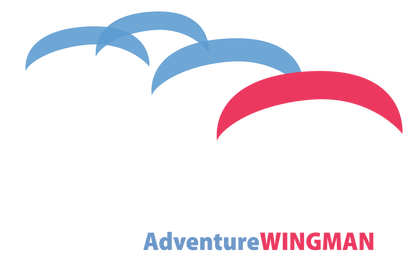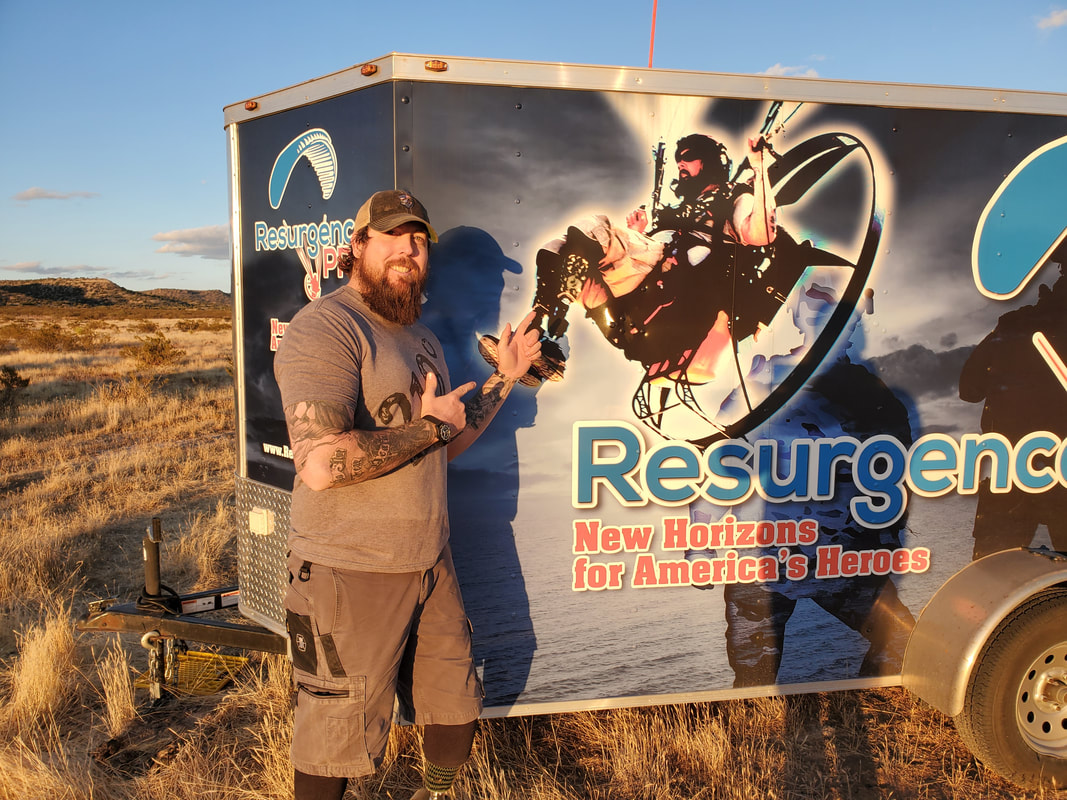|
November 15, 2020. Sunday morning was an early morning for most of the group as some of the pilots had to begin their travels back home. As the group began to disband there were some that got in a few more flights in Glamis that morning. Others were headed back to Phoenix to catch their flights home.
November 16, 2020. Monday was a recovery day as those of us that were back in the Phoenix area cleaned up our equipment and rental vans for their return. That evening a group of four remaining pilots were fortunate enough to finish off the trip in high fashion. They were able to gain permission to fly from the Pinal Air Park just north west of Tucson. This site is significant because it is one of the largest staging locations for commercial airliners in the United States. The airport is famous due to the sheer number of large commercial planes parked all around the property. Many of the planes are in a mothball status awaiting a return to active flying. It was immensely enjoyable finishing up the trip by flying among such giants of the sky while being strapped into a small two stroke motor and a nylon wing over your head. The following day everyone was either already home or on their way. From the outset, the purpose of Adventure Wingman was to do something outside the norm while sharing the experience in a way to expand the sport. I would contend that this group absolutely encapsulated the ideals and goals of Adventure Wingman. Nowhere else has such a diverse group of disabled and adaptive veterans been brought together for such an incredible type of adventure. Although the flights were not as challenging as say an Icarus race scenario, each location presented their own challenges for the pilots. As a group they overcame these challenges and had an amazing time. The greatest validation for the experience had to have come from a number of different instructors that have been involved in international adventure flying. They stated that this event was one of the best trips they have ever been on. That sentiment was shared by nearly all of the pilots. The greatest challenge now is planning the next trip and trying to replicate the magic that so many of us experienced on this trip. Thanks and acknowledgments: I have to thank Miroslav Svec, Adventure Wingman, Scout Paramotors and the Scout owners for allowing this dream of a trip to become a reality. It was Miro’s vision of expanding horizons through adventure flying that was the spark to organize this trip. For that, thank you Miro. Special thanks also go out to the Instructors and Schools that attended and provided support on this adventure. Without their assistance and support, this trip would not have been nearly the success that is turned out to be. Team Fly Halo – Canyon Hansen and Boyd Stratton One Up Adventures – Travis Burns and Kyle Mooney FlyMIPPG – Mike Cotter and Justin Fox Nebraska Paramotor – Josh Boden Predator Paramotor – Chris Holbert Class Q Airspace – Johnson Qu Desert Aviators LLC – Jeff Fletcher I must also thank all of the supporters that have made donations to Resurgence PPG to support our programs of getting veterans in the air. We hope this adventure solidifies your belief in our cause and motivates you to share our story and mission with others. This adventure was captured by numerous camera men and is currently in editing in the hopes that we will have an amazing documentary about this trip in the not too distant future. Please stay tuned for the release.
1 Comment
November 14, 2020. Saturday found us enjoying some incredible opportunities to fly and explore the Glamis Sand dunes. Pilots were free to do their own adventuring. Flying around the dunes had so many different things to offer. Sections of the dunes made it seem like you were flying on another planet. It was magical. One of the greatest joys was catching up to a group of buggies racing through the dunes and flying along side of them. It was definitely an experience that everyone involved enjoyed. That afternoon we were honored to be asked to participate in a flag ceremony to commemorate all of the attending veterans that were at the Glamis Sand dunes that weekend. The event was organized by the Glamis Veterans Organization which is a nonprofit that provides support to the Glamis enthusiast veterans. Several of the pilots elected to fly out to the ceremony and made a grand entrance in front of several thousand attendees. Unfortunately, this was where we also experienced our first injury. One of our pilots was experiencing some difficult conditions as he was approaching a tight landing area. He hit the side of a Can Am side by side vehicle and injured his ankle. There was no other damage to anything, so we were lucky in that fact. He had the pleasure of riding out on a side by side instead of flying out, but he had a great time none the less. Later this evening would see the last group flight. In an effort to capture the magnitude of the event, most of the attending pilots all launched within minutes of each other and completed a final group flight over the camp area. This flight would consist of 26 pilots in a gaggle, flying tightly over the camp. It was a treat for the thousands of campers that were there for the weekend. November 13, 2020. Friday morning was a huge culminating day for us. Scott Ritchie had planned a 40-mile cross country for us from Yuma, Arizona to the Glamis Sand dunes in California. This preflight briefing had been the most involved with controlled airspace that we would be skirting along the route. Scott had also coordinated for a pair of marshalling pilots that acted as an in-flight way point. As each group of pilots arrived at the waypoint, the marshalling pilots in the air would point them in the right direction to avoid the airspace and terrain conflicts along the route. As we made our way to our landing area in the sand dunes, we gathered as a group to make a mass arrival. With 25 plus pilots in a gaggled formation we flew into an area of campers and motorhomes to the surprise and amazement of the gathered group of well over 150,000 people. Not all of us pilots were aware of the magnitude that the Veterans Day weekend had on the side by side, motocross community. They came out in mass to enjoy riding their dune buggies, rail cars, side by sides and motorcycles. Seeing the gathered collection of campers from the air is a sight that we won’t soon forget. It was an amazing sea of people. Upon our arrival we were treated as conquering heroes and met with unbelievable hospitality by the local pilots and their families that had organized and secured the landing area for us. Like the other cross-country flights, it would not have been an actual cross country unless a pilot landed out. We lost one pilot roughly two miles from the landing area, on the approach road to the sand dunes. It was a silly situation where his sweatshirt hood blocked his airbox and starved the motor. He had a great downwind landing and all the gear survived without a scratch. He was picked up by some local gentlemen and deposited at our campsite shortly after our arrival. Given the fact that we had experienced three motor out landings in as many cross-country flights, we were lucky that we didn’t have any injuries or damaged equipment from these events. November 12, 2020. The original plan for this morning was to conduct our next long cross country from Ak Chin, to Gila Bend. Once the group of pilots realized where we were, a change in plans was made. Instead of heading west to Gila Bend, the pilots wanted to head south east to the Eye of Grande. This is an out of commission copper mine that is simply a gigantic circular hole in the ground. Reports online state that the Eye of Grande is over 3’000’ wide and 1,000’ deep. Given this spectacle, the group of pilots were much more interested in flying over this enormous hole, rather than spend a couple hours flying over flat desert. So, the plan was changed, and we made a morning trip a few short miles to the Eye of Grande. It was impressive to see the mine from the air; it was even more impressive seeing the pilots as they tested their courage and reliability of their motors flying in proximity to the mine. Upon everyone’s return from the flight the consensus was that the flight was truly amazing and the decision to change plans was well worth it. As we were all able to come down from the emotional high of the flight, we packed up our vehicles and began the movement to the next location. We arrived in Yuma Arizona in midafternoon. After the requisite need to pull a passenger van out of soft deep sand, we were ready for some evening flying. The location that Scott Ritchie had found for us was another homerun. It was an open sandy launch site that to the due east was a huge open desert playground that led to the base of an incredible mountain range. It allowed for some amazing and fun low slalom flying among the brush and cactus. Just to the north of the landing area was a very active railroad track. This provided an incredible opportunity for some of the pilots to get great footage of American industry moving across the country via rail. This evening would also have us witness one of the best moments of the adventure. Ben Pechacek is a walking paraplegic. This means that he is neurologically paralyzed in his lower extremities. Through years of therapy he has learned to walk again. He still does not have feeling or full function in his legs, but it is as if he is walking on prosthetics, so he is able to stand and walk with some difficulty. During this trip, he had been using his quad wheeled paramotor to fly. This evening in Yuma he had the desire to try to see if he could foot launch. With the support and encouragement of everyone there, he achieved an unbelievable goal of running into the air. He successfully returned to the sky via foot launch. To say that we were all excited for him would be an understatement. We were all ecstatic. The smiles and laughter around the campfires were a bit bigger that evening. November 11,2020. This was a special day for our collective group, as it was the observation of Veterans Day in the United States. The morning began with a cross country from our landing area to a High School football field 32 miles to the south. Although the length of the cross country may have been short, it was punctuated by a tight landing zone of a football field that was surrounded by light poles and stadium seats along the sidelines. A neighboring charter school was in attendance to see our arrival and revel in the beauty of our amazing sport. As with any cross country with a large group of pilots, this flight would also have one pilot run out of fuel as he spent a lot of time loitering over the camp area waiting on the other pilots to get airborne. Fortunately, our stranded pilot made an expert landing right next to a major highway just two miles from the destination. His recovery was simple, and his actions were textbook perfect on what to do if you have to land out of your planned destination. At the completion of the flight to the high school, we gathered up all our vehicles and moved approximately two hours south to the low, dry desert of southern Arizona. We regrouped at the Ak Chin Airport, south of Phoenix. This field was a tremendous change from Sedona. Although not as picturesque, we found it to be a great location to fly from. The local pilots have done an amazing job of cleaning and manicuring the launch area of this airfield. The excitement of a lower density altitude, easier launch area, and warmer temperatures was palpable as everyone hurried to get their gear ready for the late afternoon flying sessions. November 10, 2020. This was the first day of more active flying. Most of the pilots adventured out from the camp area to take in the sights. Scott Ritchie, the local guide and organizer, led the group on a roughly 40-mile loop cross country through some of the most picturesque scenery imaginable. As the group was returning to the landing area, we experienced our first motor out situation. One of the veteran pilots, on borrowed equipment ran out of fuel and landed several kilometers away from the LZ. As nighttime was closing in, his recovery took some time as we had to traverse some very difficult terrain in the dark. Thankfully he was not injured, and the equipment made it out unharmed. November 9, 2020. This was the first day of flying for most of the pilots. It was mainly used as a day for the instructors to get reacquainted with the veteran pilots they had trained and to evaluate their progress since they had left training. It was also an opportunity to provide some additional refresher instruction to some of the guys that had not had the chance to fly nearly as much as they would have liked. Although it may have seemed mundane, this day was instrumental in building rapport among the group. Both the morning and afternoon flying sessions provided the chance for some of the other pilots to fly around some of the amazing mountains, buttes and spires of the Sedona area. The Resurgence PPG Adventure Wingman expedition was the culmination of work that brought together program alumni, the instructors from various program associated schools, and special invited guests that have been especially influential in the growth and success of the Resurgence PPG program.
In November of 2020, in the midst of a world wide pandemic, Resurgence PPG was able to gather 31 pilots in the high desert of central Arizona to begin a 10 day adventure that would take them around the beautiful state of Arizona and into southern California. November 8, 2020 was the planned arrival day for the participants. We rendezvoused on an open desert plain just south of Sedona, AZ. The location, although beautiful provided its own set of challenges. The first challenge was the altitude. The location, being in the mountains of central Arizona, sat at an elevation of roughly 5,000’ above sea level. Experiencing a density altitude of this height could be challenging for pilots that are most accustomed to flying from beaches and coastal locations. The next challenge that we faced was the various experience levels that we were dealing with regarding the veteran pilots. Although these pilots had all been through a powered paragliding school with a full curriculum, there were certain cases that some pilots only had literally a handful of flights upon their arrival to the adventure. A third challenge that we faced was the fact that we unintentionally timed our arrival to coincide with an early winter storm. Our first evening together would see temperatures dropping into the teens with a light dusting of snow. Although beautiful, this added to the difficulties of getting pilots into the air. Finally, the greatest challenge that we faced, that would be present for the entire trip was the actual disabilities or adaptive abilities of the gathered veterans. In the group of veteran pilots was the first double amputee to ever foot launch a paramotor. We had a single leg amputee that was a foot launch pilot. There was a pilot that was a paraplegic that was flying a quad wheel launch unit. Several other veterans, although they may have appeared able bodied, were dealing with injuries and ailments from IED blasts, years of wear on the body, and PTSD. This group of pilots was exceptional to say the least. Not only had they served their country in combat, making enormous sacrifices, but now they had all joined together for this amazing adventure of paramotor flight around Arizona. |
AuthorTodd Scandrett Archives
January 2024
Categories |




 RSS Feed
RSS Feed